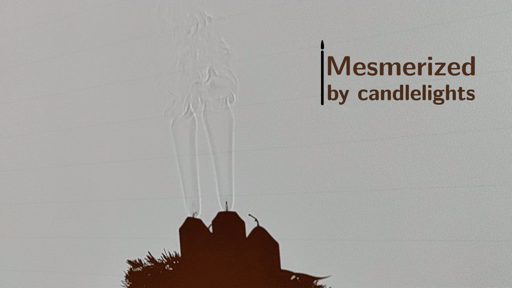The intimate atmosphere of candle-lights had fascinated many of us. We might have observed their flickering, but probably we did not think about this as an oscillation phenomenon with an almost perfect periodicity, similar with the periodic beating of pendulum clocks. Using however a high-speed camera we can visualize its periodicity of about 10 flashes per second, a phenomenon that is detected by our eyes as flickering. One can also remember that the flame of a thin candle is usually stable, and flickering appears when we construct bundles from them, unifying their flames. If the candle is thick enough, the flame of a single candle may also become unstable producing hence flickering. The phenomenon becomes even more interesting if we approach multiple oscillating flames, generating fascinating collective oscillation modes.
Placing the oscillating flame of two bundles at short distance one will observe that they synchronize their flashing. The observed dynamics resembles spontaneous synchronization, a phenomenon that is already known for interacting metronomes or other puzzling collective behavior in biological or social ensembles: rhythmic applause, flashing of fireflies, chirping of crickets, firing pacemaker cells in the heart or neurons in the brain. Placing now the bundles at a larger distance the in-phase synchrony shifts to counter-phase synchrony, meaning that whenever one of the flames is at its maximum the nearby flame will be at minimal intensity. The Dutch physicist Christian Huygens discovered similar anti-phase synchrony already in the middle of the XVII century while studying pendulum clocks hanged on a common support. In his seminal letter to the Royal Society, Huygens argued that the tinny interactions mediated by the common support of the pendulum clocks is responsible for their “strange antipathy”. We know nowadays that he was right, and indeed interaction among the elements is responsible for all such emerging phenomena in oscillating systems. In case the flame of the bundles is placed at even larger distance no collective oscillations (in-phase or counter-phase synchrony) is observable, and the flames will oscillate independently.
Researchers from the Physics and Chemistry Departments of the Babes-Bolyai University have recently published interesting novel results and a theoretical model for this puzzling phenomenon in the well-known open-access journal Scientific Reports belonging to the Nature publishing group (https://www.nature.com/articles/s41598-020-78229-x).
It is worth mentioning that the first author of the work is a second year master student from the Physics Department, Attila Gergely who constructed the original home-made experimental devices, which were further used mostly by himself to perform the practical work of the present study..
The article of the BBU team demonstrates that the flickering frequency of the flames can be controlled both by the size of the candle bundle (number of candles in the bundle) or by the oxygen concentration in the flame’s environment. In the studies concerning the collective behavior of nearby flames the researchers revealed how the synchronization level changes as a function of the separation distance between the flames and the number of candles in the bundles.
The study proposes also a simple dynamical model for explaining all the experimentally observed phenomena. The model considers differential equations for the coupled evolution of the temperature and oxygen concentration in the flames. According to their theoretical description the puzzling collective behavior is due to the airflow between the nearby flames. Changes in one of the flame temperatures will induce airflow in its vicinity and consequently will influence the oxygen concentration in the nearby flames. This will have then an immediate feedback on this flame’s temperature and size. The short video-abstract provided by the authors offers further interesting details about the study: https://youtu.be/0u_WprnAk9o

